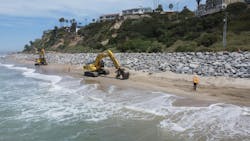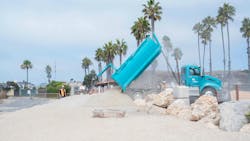How Transit Agencies Across the U.S. are Adapting Infrastructure to be Climate Resilient
As heavy precipitation events become more frequent and severe, average temperatures continue to increase and sea levels rise as glaciers melt and ocean volumes burgeon due to rising water temperatures, weather-related impacts to public transit systems have become more commonplace, requiring resiliency efforts to sustain passenger service.
Multiple transit systems have grounded to a halt because of infrastructure designs that weren’t built to withstand the current climate conditions, though agencies have begun work to target these problems and keep systems running. These issues pose costly as not only must agencies endure the emergent cost to restore service at the time of incident, but also due to the lost revenue of riders that can’t utilize these services during down events.
While the issue of climate change impacts all agencies, the products of the severe weather it produces poses unique challenges for each of them. From New York City’s Metropolitan Transit Authority (MTA) subways and buses flooding multiple times during heavy rainfall, to Bay Area Rapid Transit (BART) having a heat-related derailment and service slowdowns during heatwaves and Orange County Transportation Authority (OCTA) having service suspensions as coastal erosion caused by storm surges impact its coastal rail line, these systems host individual problems that have require region and weather-type specific solutions with implementation underway.
Coastal erosion and bluff slides: An update on OCTA
OCTA had temporarily suspended service along the portion of the Los Angeles – San Diego – San Luis Obispo (LOSSAN) rail corridor due to a combination of debris from the bluff side of the track and from track destabilization from coastal erosion on the coast side of the track.
OCTA Communications Specialist Eric Carpenter describes how the agency is breaking down the resiliency efforts to keep passenger service going without interruption into the future.
“We have identified four, what we call hotspots, that we want to address before they become a problem, and at the same time, we’re leading a study that looks at trying to preserve the rail line in place for roughly the next 30 years,” Carpenter said. “Beyond that, we’re working with the state of California to look at a longer-term study that would look at solutions for generations to come.”
The agency’s approach is two-fold:
- Contain landslide debris that may continue to fall off the privately-owned bluffs above the track.
- Reinforce the coast below to ensure the track remains in place and is better protected from storm surge.
For the bluffs, OCTA is creating a 1,400-foot catchment wall that will stretch from the El Portal Beach access point to Linda Lane. The wall will be a permanent structure that’s designed to complement the coastal landscape. Construction of the catchment wall began on Sept. 15, 2025, with an estimated completion date in the summer of 2026.
For the coast, OCTA has begun the process of sand nourishment along North Beach in San Clemente. The agency placed approximately 2,500 cubic yards of sand between the rail line and the ocean in mid-September—a move the agency calls a “deposit” on a larger effort to reinforce the coast. Its overall goal is to add a total of 540,000 cubic yards of sand along the San Clemente coastline, pending further state and federal permitting approvals and the sourcing of that volume of sand.
“One thing we heard repeatedly during our community meeting is about the importance of sand,” Carpenter said. “People are really concerned about the coastal erosion, and they want to make sure that sand is part of any solution for protecting our rail line.”
The agency is taking the opportunity now not only to protect and conserve the rail line’s usage, but also because of the financial benefit of acting. While this nourishment project will cost $900,000, the agency notes it’s an investment in the future.
“What we found is that once it becomes an emergency, it’s always the worst case in terms of having to pay for emergency repairs, and the more we can plan for this in advance, the better it is economically,” Carpenter said. “Ultimately, our goal as a transportation agency is to make sure this rail line continues to run, and it’s run pretty much uninterrupted for 125 years.”
Carpenter stresses the agency is learning as it goes as it deals with the unprecedented times that are generating emergencies that the agency wasn’t anticipating even as recently as 10 years ago.
Rain related flooding: An update on MTA
As the largest subway system in North America, the MTA is often the most noteworthy example when flooding on public transit occurs, like MTA experienced in mid and late July 2025. These floods forced several subway lines to skip stops, reroute or cancel service altogether because of unusable track and station flooding. Bus services were also impacted as operators worked through streets that were quickly flooding.
The flooding results from a lack of adequate drainage required from storms that are more significant than when the subway and sewer systems were created. The city’s sewer system and the subway’s drainage system, which were built more than 100 years ago, are designed to handle 1.75 inches of rainfall per hour, as noted in the city’s Climate Resiliency Roadmap. However, the storms that caused the flooding in July produced rainfall totals that exceeded 2.5 inches per hour. That system is also not just handling storm runoff, as it’s a combined sewer system that handles wastewater as well.
To handle this, the MTA has begun implementation of a multi-pronged approach outlined in its roadmap that engages multiple city agencies to prevent major infrastructure downtimes.
The implementation will come in two forms:
- Keeping water out of the subway system.
- Better methods for removing water that still invades.
The phase of keeping water out begins with better waterproofing of subway tunnel walls with a long-term grouting program coupled with tunnel inspections and spot grouting as needed. Further, the agency is working to improve sidewalk-level protections at stations most prone to flooding with measures such as more significant safeguards for vent batteries that aid in keeping water out and examining new mechanical vent closures that could replace those systems altogether.
In removing water that still enters, the MTA is working to upgrade or rehabilitate aging pump rooms at priority stations where possible, as well as expanding capacity at stations with the most significant needs. It’s also working to decouple direct connections between its track and vent drains from the city sewer system while increasing the capacity of constrained vents where possible. Finally, the agency is working to implement a stormwater retention and detention system that would allow that water to be held until it can be safely discharged without overwhelming drainage systems.
The MTA also faces challenges above ground, both with at-grade and open cut subway infrastructure and in the streets its bus network operates on. To address the subway infrastructure challenges above ground, the agency seeks improvements like increased pumping capacity while also bolstering programs that keep drains clear in preparation for torrential rain events.
Regarding bus operations, the agency notes in its roadmap that 95% of bus routes encounter at minimum one street that experiences stormwater floods during torrential rain, an issue it intends to combat through partnerships with the New York City Department of Environmental Protection and the New York City Department of Transportation. In the short term, these measures will include alternate route planning, so buses may still proceed with service during rainfall events. In the long term, MTA is considering permanent route and stop changes to keep buses off the most impacted streets while working on other at-grade and sidewalk level improvements.
In a statement to Mass Transit magazine, the MTA has expressed its continued efforts at making the system resilient, referencing its plans of mitigation and its commitment of funding.
“The MTA is working harder than ever to invest in climate resilience to protect the largest transit system in North America from coastal storms and torrential rainfall,” an MTA spokesperson said in a statement. “…We've committed $700 million in flood protections as part of the 2025-2029 Capital Plan, which will fortify more parts of the system from the increasing effects of climate change.”
Extreme heat challenges: An update from BART
BART has seen a share of heat-related issues to its system, ranging from general passenger discomfort to aging equipment that can overheat and cause service delays, extreme heat causing sun kinks—an impact of high temperatures that causes tracks to bend or become distorted—and a partial derailment the agency says was heat related.
To remedy these situations, BART has been making strides to address heat-related impacts to passengers and service. For instance, BART has created a weather guide to alert riders to how the heat can impact BART services.
“This [guide] helps riders to learn more about how weather can impact BART. BART runs trains at reduced speeds during extreme heat events. This is common practice for rail systems with open-air tracks across the world,” said BART Communications Officer Chris Filippi. “BART is very transparent with riders when we run trains at reduced speeds, and we issue BART service advisories and make announcements, so people know what to expect.”
Dictating those reduced speeds are temperature sensors the agency has implemented along its rail tracks. They allow BART to keep tabs on temperatures and reduce speeds should they exceed 115 degrees; a threshold the agency has set in an effort to prevent heat-related derailments.
BART is also taking steps to prevent heat-related expansion before the track even meets the ground.
“BART rail is heat-treated prior to installation, which allows for thermal expansion of the rail,” Filippi said. “However, when there are sharp rises in ambient temperatures, the thermal forces exerted on the rail increase, making it possible for the rail to expand beyond its designed temperature.”
The agency has also accented these preventive measures with increased BART crew inspections in the most heat-prone areas to ensure passenger safety and to protect its infrastructure through extreme heat events.
The impacts on ridership patterns from extreme weather
A recent study conducted by the University of Oregon examined the ridership patterns of transit systems across 48 U.S. cities over an 18-year period (stopping at the end of 2019 to not have COVID-19 ridership reductions impact the data) in comparison to extreme weather patterns to see how ridership was affected during extreme weather events.
Principal researcher and Associate Professor of Disability Studies Nicole Ngo, Ph.D., notes her team found reductions in ridership across all studied weather types: very hot days, very cold days and days with heavy precipitation.
“We find this trend pretty consistent over time, especially for very cold days and on very rainy days, but more recently, there’s sort of a stronger effect when the weather is very hot,” Ngo said.
While the study could only compare ridership totals on a monthly basis due to available data, it did see drops in ridership in months with additional very hot or very cold days above the baseline. Further, when an area experienced a heat event—a four or more day period with temperatures above the 90th percentile for the area—ridership impacts were greater for each additional day than for single day events of extreme heat. The researchers saw decreases of .14% of the mean unlinked passenger trips (UPT) per capita from the baseline of three UPT, which is the average number of trips over the study period. This was an occurrence that increased from 2016 through 2019. The study also found that bus ridership was more sensitive to heat than rail ridership.
Throughout the study period, ridership levels were consistently lower on days with heavy precipitation; ridership levels remained steady at these lower levels even as days with heavy precipitation became more common.
Heavy precipitation, defined as precipitation above the 90th percentile for an area, saw both bus and rail ridership decreasing during these events. The trend of bus ridership being more sensitive also continued, though the impacts did not become more severe with additional days of precipitation.
While Ngo says the overall effects are modest as “if you have to get to work, you have to get to work,” she acknowledged how this could have future impacts.
“Even though our study took place before [COVID-19], this could lead to concerns over future trends, especially as... these very hot days and cold days and days of heavy rain are expected to become more common,” Ngo said.
Climate change has impacted transit systems across the country, though how agencies manage those impacts differ due to their specific needs. The MTA and OCTA are actively piloting resiliency solutions to reinforce their systems. Resiliency efforts in other systems have shown fruitful. For instance, BART hasn’t seen a similar derailment event to the one it experienced in 2022 since it implemented heat-resistant solutions to combat its previous problems. While there’s no one-size-fits-all solution, resiliency efforts keep passengers moving and should continue to be at the forefront of current and future planning.
About the Author
Noah Kolenda
Associate Editor
Noah Kolenda is a recent graduate from the Craig Newmark Graduate School of Journalism with a master’s degree in health and science reporting. Kolenda also specialized in data journalism, harnessing the power of Open Data projects to cover green transportation in major U.S. cities. Currently, he is an associate editor for Mass Transit magazine, where he aims to fuse his skills in data reporting with his experience covering national policymaking and political money to deliver engaging, future-focused transit content.
Prior to his position with Mass Transit, Kolenda interned with multiple Washington, D.C.-based publications, where he delivered data-driven reporting on once-in-a-generation political moments, runaway corporate lobbying spending and unnoticed election records.





